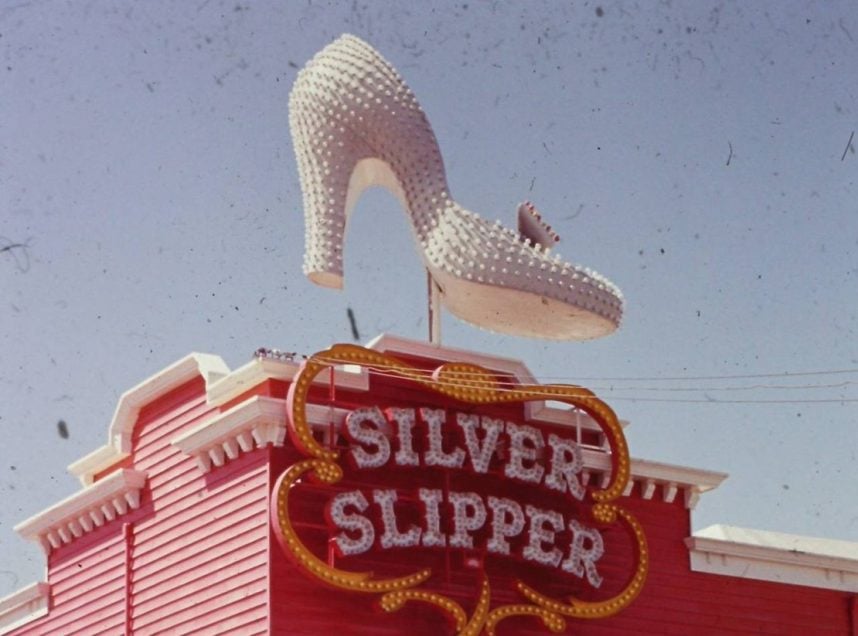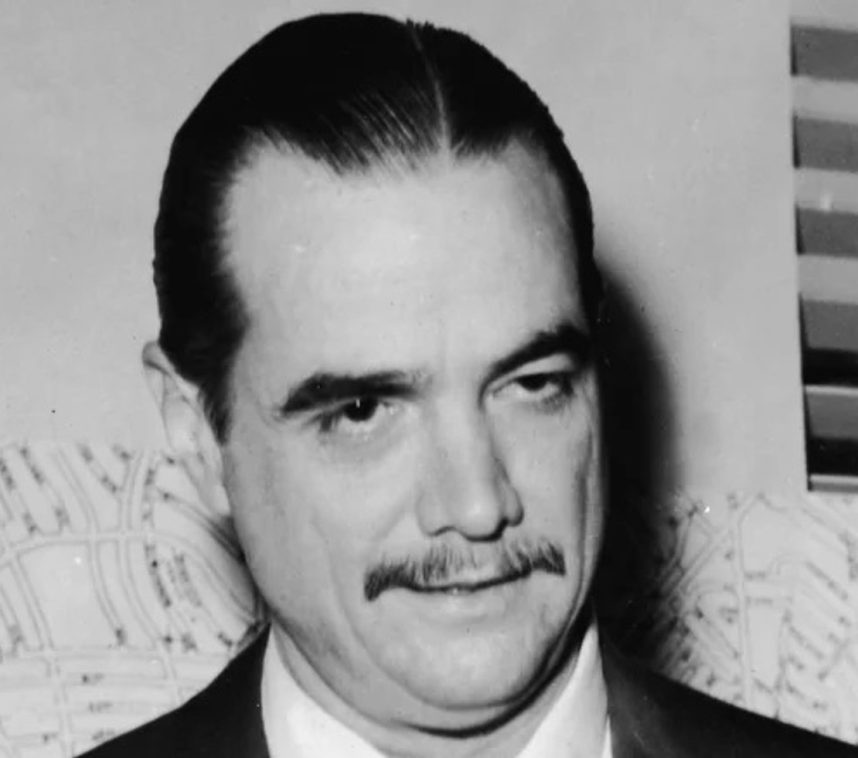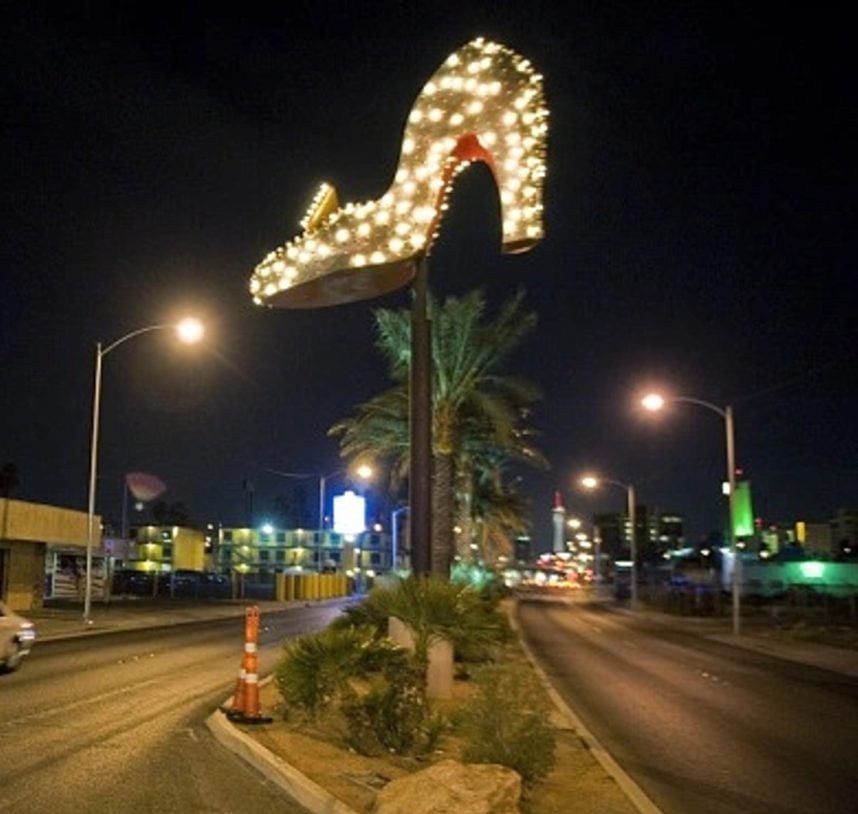Vegas Myths Re-Shattered: Howard Hughes bought a silver slipper just to darken his sign

Published on: November 10, 2023 at 08:04 pm.
Last updated on: 15 November 2023 at 06:48 h.
Editor’s note: “Vegas Myths Busted” posts new entries every Monday, with a bonus Flashback Friday release. Today’s post in our ongoing series was originally published on May 1, 2023.
This is effectively our second Howard Hughes legend, and there are still many more to bust. The world-famous aviator and movie mogul supposedly began his famous buying spree of Las Vegas casino hotels, partially freeing the sector from the shackles of Mafia ownership and paving the way for the era of corporate ownership, all thanks to the giant shoe atop the silver slippers.

The 12-foot-tall, 17-foot-wide spinning high heel was designed by Jack Larsen Sr., a former Disney animator who worked at YESCO Sign Company, where he also created the pop art lamp for Aladdin. Larsen’s silver sign is modeled after one of his wife’s pumps, and features 900 glowing lights on the shoe and 80 on the bow. It was installed in late 1954 or early 1955 and was deployed until the resort closed in November 1988.
According to the story, the shoe, located directly across the strip from the Desert Inn, which Hughes had used since arriving in Las Vegas the day before Thanksgiving in 1966, was so bright that Hughes was unable to sleep at night.
The story goes that the Silver Slipper refused Hughes’ requests to darken the shoe, so he bought the Casino Hotel and darkened it himself. This gave the eccentric billionaire the idea of buying Vegas hotels, and he bought a bunch of others.

This myth has appeared in books including “The Strip: Las Vegas and the Architecture of the American Dream” (2022) and “When the Mob Ran Vegas: Stories of Money, Mayhem and Murder” (2005) and in legitimate publications such as Los Angeles Times.
As is often the case with urban legends, they also come in other forms. A version that appears in the current version of the Silver Slipper’s Wikipedia entry has Hughes believe that the toe of the slipper “could have a photographer taking pictures of it.” After several attempts to request that the slippers be turned off, according to the entry, Hughes “bought the casino, turned off the lights, and dismantled the spin system.”
Both stories are complete nonsense. “Complete nonsense.” Paul Wynn, Hughes’ corporate records manager from 1957 until Hughes’ death in 1976, said: Casino.org. “I don’t know where they get this stuff from.”
Of course, as is usual with Hughes, the truth was as strange as the fiction. We’ll get to that later.
Four major problems with this story
According to Winn and all other accounts of the time Hughes spent in his penthouse suite at the Desert Inn, he kept the curtains open 24/7.
- Neither the light of the casino sign nor the photographer’s lens can penetrate them. Hughes, who was undoubtedly in the grips of mental illness by that point, demanded closed curtains (and windows) to protect him from pollution, sunlight, germs, prying eyes, and nuclear fallout from regular underground explosions at the nearby Nevada Test Site. According to Winn, Hughes tried to convince President Lyndon Johnson to stop those tests, but he was not strong enough.
- The dates are wrong. Hughes’ buying spree began in March 1967. He did not purchase the Silver Slippers until April 30, 1968.
- The border sign was larger and brighter of Silver Slipper, so it would have upset Hughes more.
- We know where the legend came from – mistake Las Vegas Journal Review The report was later retracted.
Gossip and rumours
Well, it was somewhat to retreat.
On April 21, 1967, RJ Gossip columnist Earl Wilson wrote: “Colleagues say he (Hughes) asked them to ask the Silver Slipper to dim his lights. They refused. His emissaries say he ordered them to negotiate to buy the slippers so they would no longer interfere with his sleep.”
Almost a full year later, as Hughes’s purchase of the Silver Slipper was nearing completion, Wilson published what journalists refer to as an “uncorrected correction,” refuting his earlier false claim without actually acknowledging that he was the original. (There was no internet at that time to catch it).
“He doesn’t turn it off, he doesn’t turn off the lights.” Wilson wrote about Hughes’ impending takeover of Silver Slipper on April 17, 1968. “They may burn brighter than ever.”
Wilson’s follow-up proved to be such an obscure reference for most readers that they did not connect it to his original report, a report they continued to remember.
The reality of what happened
The Desert Inn rented the entire upper floor and lower floor to Hughes and his associates for 10 days. Check-out time came and went, and Hughes didn’t budge. DI owners Moe Dalitz and Ruby Kolod were horrified. They actually promised VIP suites for New Year’s Eve.
Robert Maheu, Hughes’s chief aide, asked Truckers Union President Jimmy Hoffa to intervene on Hughes’ behalf, but that only bought him a few more weeks. Maheu then suggested buying DI to his boss as the only solution. Thus began Hughes’s famous buying spree.
“Hughes never intended to buy a hotel, he just wanted a place to sleep,” Maheu told PBS in 2005.
As mentioned earlier, truth is usually as strange as fiction with Hughes.
On March 27, 1967, Hughes and Dalitz agreed on the price: $13.2 million, far more than DI was worth. Hughes then bought The Sands for $14.6 million, Frontier for $23 million, El Rancho Vegas for $7.5 million, The Castaways for $3 million, The Unfinished Landmark for $17 million, and The Silver Slipper for $5.4 million.
“He bought the silver shoes because they were available, and for no other reason.” Wayne said Casino.org. “I know. My name was on the gaming license because I was an official at the company.

When asked if he knew why the slipper brand eventually stopped rotating, Wayne replied: “I think the rotating mechanism broke down, and maybe no one bothered to fix it.”
the modern history
The Silver Slipper was sold in 1988 to hotel owner Margaret Ilardi for $70 million. She demolished it and turned it into a parking lot for Frontier, which she also owned. Fortunately, the slipper and its sign were salvaged and transferred to the YESCO Cemetery, which later became the Neon Museum’s collection.
Until now last The variation on the legend is that Hughes ordered concrete to be poured into the rotating mechanism to jam it. According to the Neon Museum, no concrete was found in the mechanism when they obtained the sign.
In 2009, the museum restored the sign and installed it, along with other vintage Vegas neon signs, in a median along North Las Vegas Boulevard, where it still shines today.
Look for “Vegas Legends Busted” every Monday Casino.org. Visit VegasMythsBusted.com to read pre-busted Vegas legends. Do you have a suggestion for a Vegas legend that needs busting? Email corey@casino.org.





